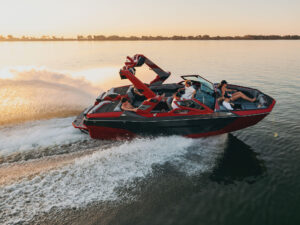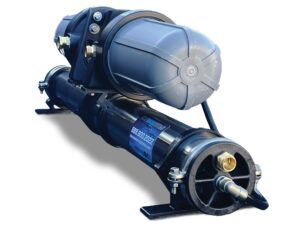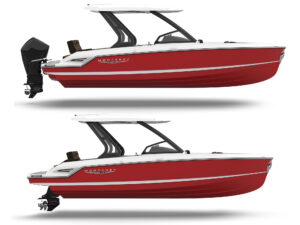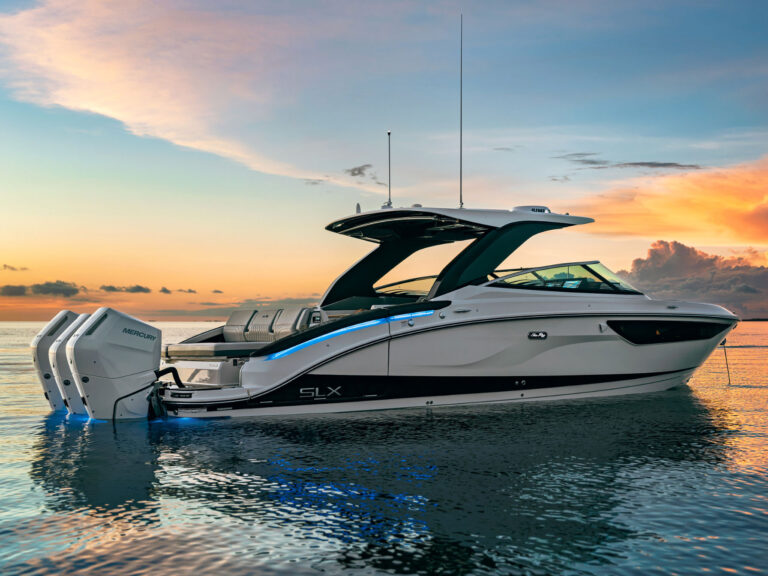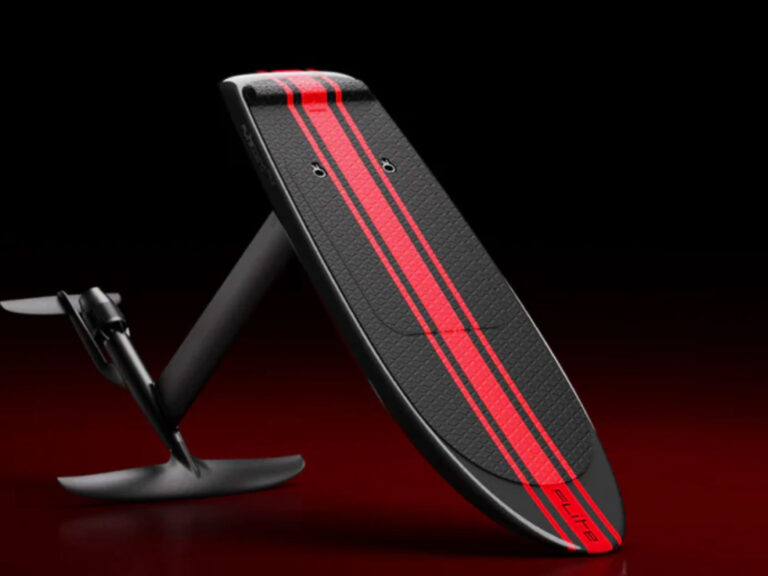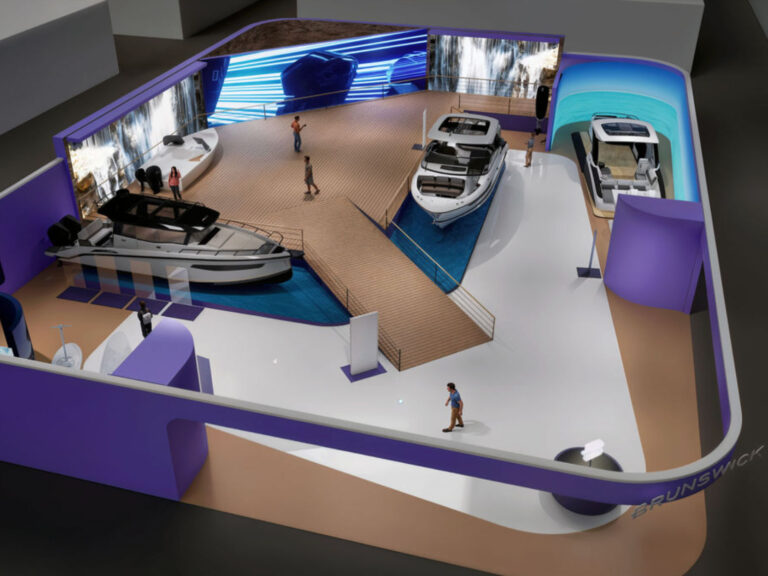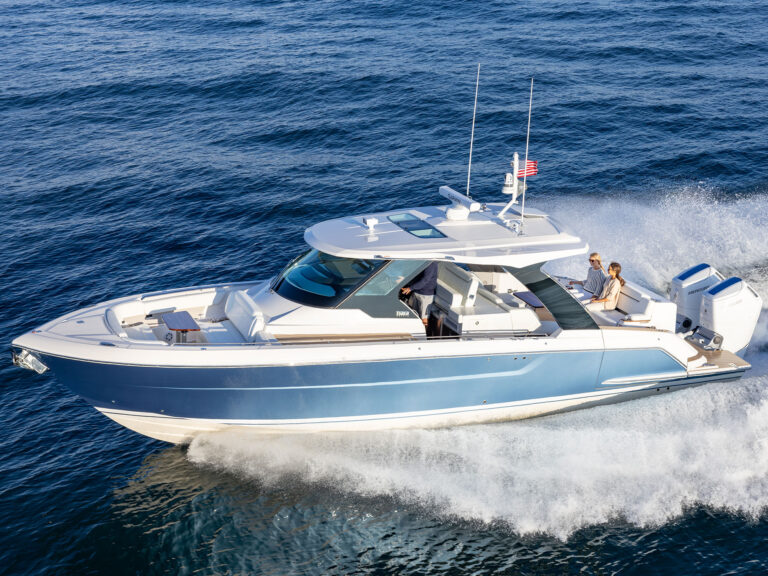
Nobody really needs a $100,000, 627 hp supercharged V-8 outboard motor. But a few people really want one — or four.
Credit Seven Marine five years ago for presuming there was a market for just such an outboard and figuring out how to create what may be the most perfect, wonderfully irrational marine mega-motor to ever hang from a transom. We’ve been dying to see how Seven Marine converts a 6.2-liter, 467-pound Cadillac V-8 into an outboard motor and, after a year of cajoling, we were finally granted a day in the Seven Marine assembly facility in suburban Milwaukee. Here’s what we found.

7 Up
The Seven Marine 557 outboard prototype debuted at the 2011 Miami International Boat Show. Its imposing V-8 and gleaming stainless-steel exhaust headers drew gawking crowds, and a few naysayers dismissed the viability of such a beast. The company splashed another Seven 557 prototype at Miami in 2012, and production started later that year.
Boating magazine was, in fact, the first media outlet to gather performance data on these engines during an exclusive test of a Midnight Express 39 with triple 557s that appeared in the June 2013 issue.
At the 2016 Miami show, 46 Seven Marine motors were installed on demo and display boats, and Seven says several hundred have been sold to date. Naysayers be damned.

Seven Marine assembles its outboards in an industrial park building that also houses its office space. It’s an assembly shop — unlike Mercury Marine or Yamaha, Seven doesn’t manufacture any of the components it designs for its outboards. It does not have the scale to open a foundry, or set up gear-cutting machine cells or even a paint booth. That’s all outsourced, and southeastern Wisconsin is sprinkled with world-class suppliers for those services who also support a cluster of heavy hitters located in the region, including Mercury Marine, BRP Evinrude, Harley-Davidson, and Briggs and Stratton. Seven says it sources parts and services from 30 Wisconsin-based suppliers.

“The value we offer our customers is the design and engineering of the outboard, the testing, the calibration and the service,” says Seven Marine President Rick Davis. “For the rest, we’ll leverage the talents and capabilities of suppliers, and there are plenty of good ones out there worldwide.”
A Seven outboard includes about 1,200 parts in addition to the engine and the ZF transmission. Some parts are easy. The engine’s serpentine belt is off the shelf from NAPA. Some are adapted. Seven uses locally machined and drilled Corvette motor mounts to mate to its bracket. Some are clever. The steering tube bushing is also used on the pivots of earthmover buckets. Some are more exotic. Seven contracts with Selva Marine in Tirano, Italy, an expert in high-volume sand-casting, to create its twin-pinion gear cases and the transfer-case casting that mates the engine to the transmission.

The actual process of building a Seven outboard usually begins many months before a single bolt turns in the shop. These are bespoke motors that often power bespoke boats and custom and semicustom craft, like the HydraSports 53 Sueños powered by four Seven 627 outboards. These boats are created in close collaboration with the customer, and Seven is part of that planning. Production of the outboards, rigging and controls must coincide with boat production, and the color scheme on the motors often complements the styling of the boat.

Some Assembly Required
The heart of the Seven outboard is an LSA 6.2L SC V-8 engine built by General Motors Global Propulsion Systems in Silao, Mexico. This aluminum supercharged engine also powers Cadillac CTS-V and Camaro ZL1 automobiles and is attractive for the Seven application because of its outstanding power density — a lot of torque in a compact, lightweight package.

The chain hoist that’s used to lift an engine from its steel shipping cradle is a good place to start the Seven assembly story. The first assembly station is actually devoted to partially disassembling the V-8 so it can be sent out for paint, a task that takes about three hours. To create a 557, this entails removing all the parts that won’t be painted and then masking over spots where you don’t want paint, like the opening of the throttle body and the pulley runs. Dozens of bolts are screwed into the block and heads to keep paint out of those threaded holes. In building this engine, we opened the intake plenum chamber on top of the engine and replaced the aluminum GM charge air cooler with a Seven-designed cooler that’s about 30 percent larger and made of a copper-and-nickel alloy that can tolerate raw water.
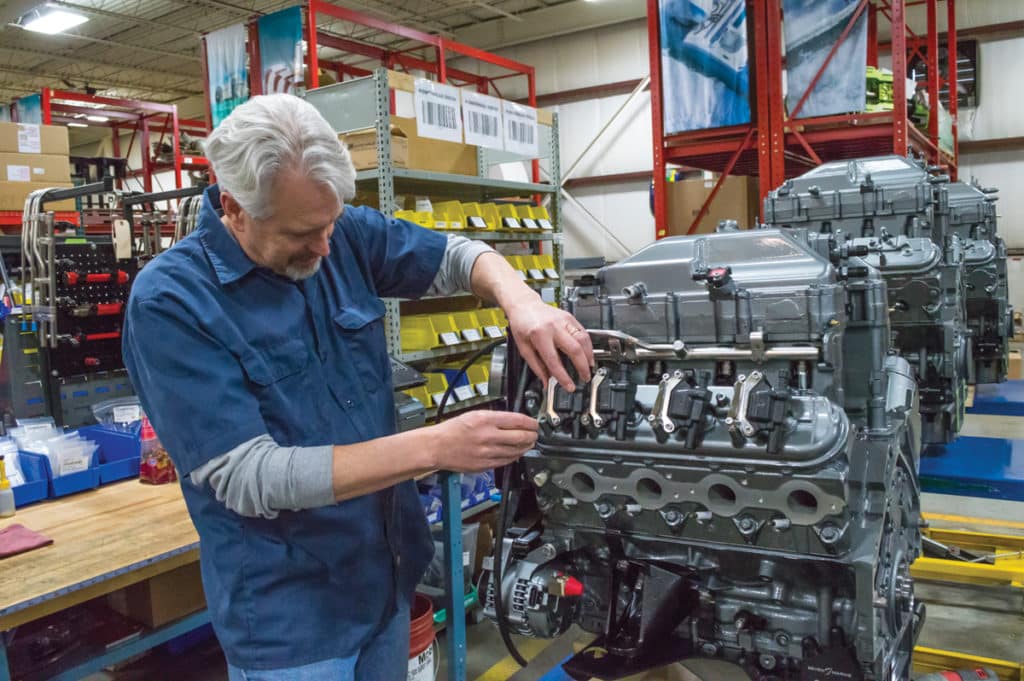
The 627 engine requires more work. The cylinder heads are removed and exchanged for a set with combustion chambers machined at Lingenfelter Performance Engineering. The LSA camshaft is swapped for the cam from the LS9 engine that powers the Corvette ZR1. The masked-off engine is sent out for a multistep painting process applied at Calibre Inc. in Grafton, Wisconsin. Calibre also executes all the cowl paintwork for Seven, which can be insanely complex. The Calibre pedigree is impeccable — the shop paints most of the custom sheet metal for Harley-Davidson. Paint turnaround on the engines can be several weeks.

Next, we move to a workstation devoted to the assembly of the transfer case. The transmission is located directly below the engine. Power from the horizontal engine crankshaft moves through a set of five vertical gears in the transfer case to the horizontal transmission input shaft. The sand-cast housing for the transfer case is a key, multifunction component Seven engineered for the outboard. It supports the rear of the engine, transfers torque to the transmission, houses a dual-impeller direct-drive water pump, manages the flow in and out of the pump, and forms part of the exhaust housing. Davis gushes over the craftsmanship.
“The folks at Selva are real artisans of sand-casting,” he says, holding the casting up to the light and moving his fingers over the surface. “Each part is hand-finished to perfection, and they machine to our spec and perfectly match our paint.”
Davis shows us how to assemble the gears and shafts in the case, using a press to set bearings. Another crane hoist is used to lift a black ZF transmission from its shipping crate. Set in a fixture, the transmission is bolted to the transfer-case assembly, and the correct-length midsection is bolted to the bottom of the transmission.
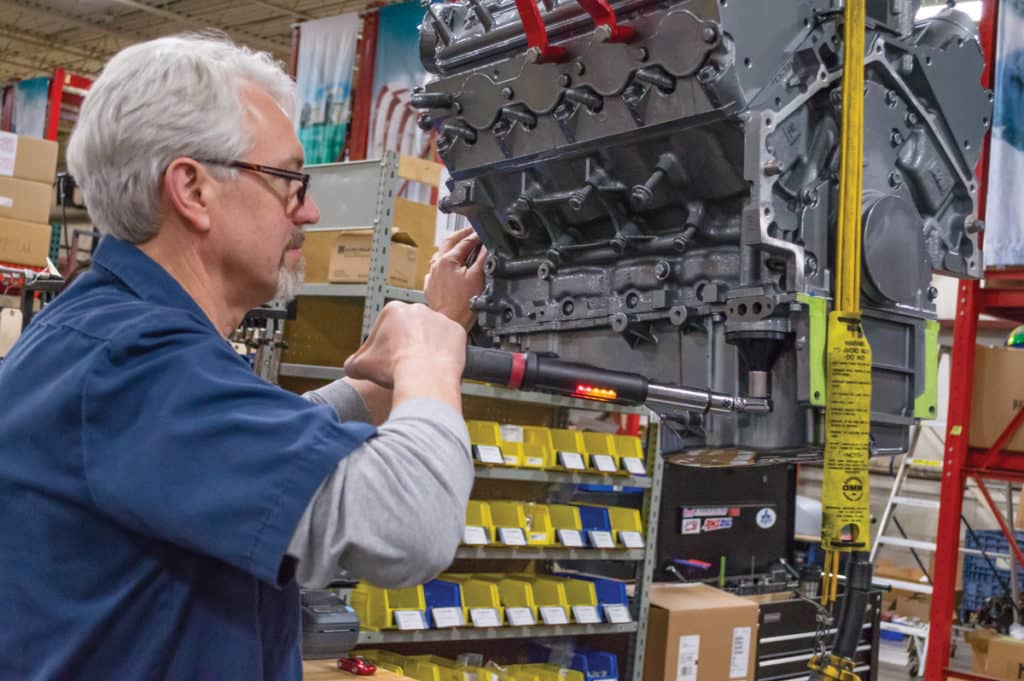
Back in the engine area, we work on a V-8 that has returned from the paint shop, removing the masking bands, tape and bolts while the engine is on a hoist. Then it’s time to dress the engine using some OEM parts and others specific to Seven. We start with an aluminum cowling plate that fits around the oil pan and prevents water that migrates under cowl from reaching the engine. The routine is to finger-start each bolt, snug it with a power driver, and then finish each with a digital torque wrench. The engine’s oil-filter mount is covered with a black aluminum cone-shaped “witches cap.” We reinstall the OEM coils on the valve covers using Seven’s polished stainless-steel brackets.
The transfer case and transmission assembly, including the clamp bracket and midsection, are joined to the semidressed engine. The Seven mounting system is a typical outboard design with a pair of clamp brackets and a swivel bracket, but every component is supersize. We’re handed the stainless-steel steering tube and head, which has a 1.75-inch diameter shaft and must weigh 30 pounds.

Next, we get to install the sexy stainless-steel exhaust headers, created by Custom Marine of Neenah, Wisconsin. A peek into the headers reveals the skilled welding and design required to create the water jacket. It takes a Seven tech three to four hours to completely dress the painted engine.
Next, the trusty chain hoist lifts the engine-transmission assembly onto a water-filled test tank. After rigging fuel and electrical lines, we start the engine to check water and oil pressure and look for leaks. The gear case, shipped as a complete pretested assembly from Selva, is attached after the test-tank session.
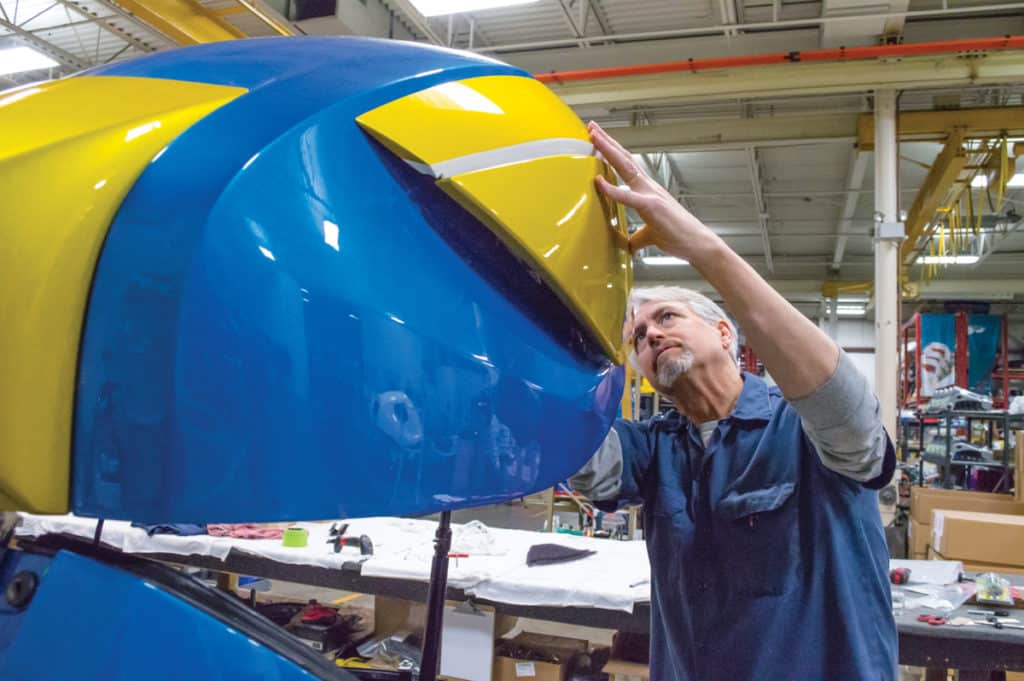
The biggest workstation is devoted to assembly of the cowl parts, which, for our motors, return from Calibre with brilliant blue and gold finishes. Working on a carpet-covered bench, we add mounting hardware and seals and snap in the SpectraBlade LED strips before joining the side panels to the top cowl piece. The cowl gets a test fit and is removed before securing the completed motor to a wooden shipping pallet. Then the cowl is placed on the motor and wrapped in a protective cover. A cardboard lid fits over the motor, and it’s ready for shipment.
Seven plays a consulting role in the rigging and testing of its motors, a hands-on approach that’s perfectly aligned with its hand-built assembly system. It’s the only way to create the outboard that nobody really needs but many totally want.

As the saying goes, if you have to ask, you likely can’t afford one. Seven Marine & Spectrablade
Seven 557: $79,900
Seven 627: $89,900
Optional SpectraBlade LED Package: $3,761
Rigging: $10,000 to $20,000 per outboard (higher with digital controlsand a joystick)
Custom Paint: Priced to order

A Big Idea
Why not build a 1,000 hp outboard? That was the idea Eric Davis tossed out to his father, Rick, in 2009. The pair had formed the consulting firm Davis Engineering and was working on an ATV concept and other projects after Rick retired as chief technology officer at Mercury Marine and a 32-year career in the marine-engine industry.
“Eric looked at boats running quad outboards and thought that two really powerful outboards would be a better solution,” says Rick, 64. “His original idea combined a big-block Mercury Racing engine with the transmission from a Zeus pod drive and a Merc Racing Six gear case. He actually created a CAD drawing. He had a why-not attitude and an answer for every ‘yeah, but’ problem I could identify.”
A fortunate confluence of circumstances made it possible. First, internal debate over future engine designs at General Motors pitted supporters of the dual-overhead cam Northstar V-8 series against proponents of the pushrod small blocks.
“The small-block faction won, and we have this very compact, lightweight and powerful Gen IV V-8 for our outboard,” Rick says.
The ZF transmission used by Seven was originally designed for a downsized pod drive that never made it to production.
“I was aware of the transmission when I was at Mercury,” Rick says. “There’s no way that we could finance the creation of that transmission ourselves, but here ZF had it all engineered and ready to go.”
Eric’s younger brother, Brian, 38 and also an engineer, joined the Seven team to handle marketing and sales.
“I set up meetings with boatbuilders at the 2010 Miami boat show just to present the idea,” Brian says. “A few thought we were nuts, but we had enough interest to move forward.”
A year later, the Seven Marine 557 was on display at Miami.

